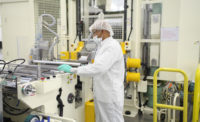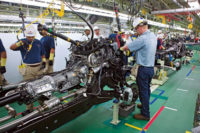Perhaps the biggest takeaway from the past couple of years was recognizing how simultaneous events—wars, pandemics, natural disasters—can have significant global implications.
For manufacturers, these “compounded extremes” have provided incentive for better planning. They have also sparked a call to strengthen the domestic supply chain, especially for crucial products like medical devices and semiconductors. Many manufacturers are opting to reshore production—to bring manufacturing and services back to the United States from overseas.
If manufacturers are to survive in today’s dynamic and unpredictable world, they must be more flexible than ever. The companies that will thrive are not necessarily the largest or most innovative, but the ones that have the flexibility to adapt quickly to changing needs and unexpected events. Indeed, a recent survey conducted by Starline found that manufacturers will make at least one significant change to their production environment every six to 12 months.
There are any number of reasons a company might decide to move its manufacturing operations to a facility in a different location. It might want to get closer to a customer. It might want to expand or consolidate. Or, it might simply be looking for tax breaks or lower real estate costs.
The COVID‐19 pandemic is a classic example of an unexpected event that required companies to rethink their business models. The pandemic forced many manufacturers to reorganize their facilities and operations around employee safety. A big challenge was how to introduce the concept of social distancing into manufacturing work environments. For some companies, this required them to reorganize equipment and workstations to provide a safe distance of six feet between employees as they were working.
Flexibility and Personnel
Unfortunately, becoming more flexible isn’t so easy, given the current state of manufacturing employment. According to a report from Deloitte and The Manufacturing Institute, “Creating Pathways for Tomorrow’s Workforce Today: Beyond Reskilling in Manufacturing,” the pandemic outbreak initially erased approximately 1.4 million U.S. manufacturing jobs, undoing more than a decade of manufacturing job gains. While the industry was able to hire back 1.2 million of these jobs through March 2022, the remaining 175,000 have not been added back, despite more than 500,000 job openings.
If that wasn’t bad enough, our country’s electrical workers are aging. Electrical workers are retiring at a rapid pace, and the training of new electricians is failing to keep up. According to data from the Census Bureau, the median age of electricians in the U.S. is 41 years old. At the same time, the Bureau of Labor Statistics has estimated that the need for electricians over the next 10 years will grow by more than 10 percent, based on current policies and trends.
And that’s a problem. When companies are forced to retool or reconfigure production layouts, it will invariably require modifications to the facility’s power distribution system. For decades, manufacturers have relied on traditional electrical conduit and wiring systems—informally known as “pipe and wire systems”—to deliver power to manufacturing equipment, such as assembly‐line machinery.
These pipe and wire systems have numerous drawbacks, the primary one being their lack of flexibility in adapting to changes. Whenever manufacturers must move, add or replace machinery on the factory floor, they must often reconfigure their power distribution system, which means hiring outside labor to run additional wiring. That means increased labor costs, complicated scheduling, and potentially considerable downtime.
Fortunately, there is an alternative. A track busway system provides the same high‐performance power delivery as traditional pipe and wire systems. But, track busways also offer the flexibility to make quick and easy changes to a power distribution layout and the scalability to accommodate higher power loads. A track busway system lets anyone adapt their power distribution to the changing needs of the facility, with far less trouble and cost.
Unlike traditional wiring, open channel busways enable operators to relocate power access points and outlets directly where power is needed in a matter of minutes—without contracting scarce electricians. A busway’s continuous access design makes this flexibility possible. Contrary to bus-duct systems which have fixed access points called ports, the full length of the busway is available for inserting plug-and-play tap-off boxes. Point of use power lets manufacturers arrange their power access to suit their production layout requirements.
Busway systems can also be installed faster than traditional conduit installations. For example, the rapid installation and flexibility afforded by busways enabled a major Detroit automaker to reconfigure a portion of its assembly plant for ventilator manufacturing in response to the COVID-19 pandemic. The automaker was able to source materials, train its employees, and reconfigure its facility in just 11 days.
Conclusion
There are many unforeseen challenges and planned changes facility managers are continually facing. Properly responding to these issues can mean the difference between maintaining profitability and experiencing unnecessary long‐term costs. Leveraging an agile, high‐performance power delivery system will help you avoid the latter.
A track busway system provides a competitive edge for any manufacturing company, allowing you to make quick changes to power delivery with little to no interruption. When reconfiguring machinery, a track busway lets you quickly return to full productivity, with minimal difficulties and downtime. If you’re scaling up your manufacturing operations with a new or expanded facility, a track busway system allows you to open that facility faster since the busway system can be installed up to 90 percent more quickly.


